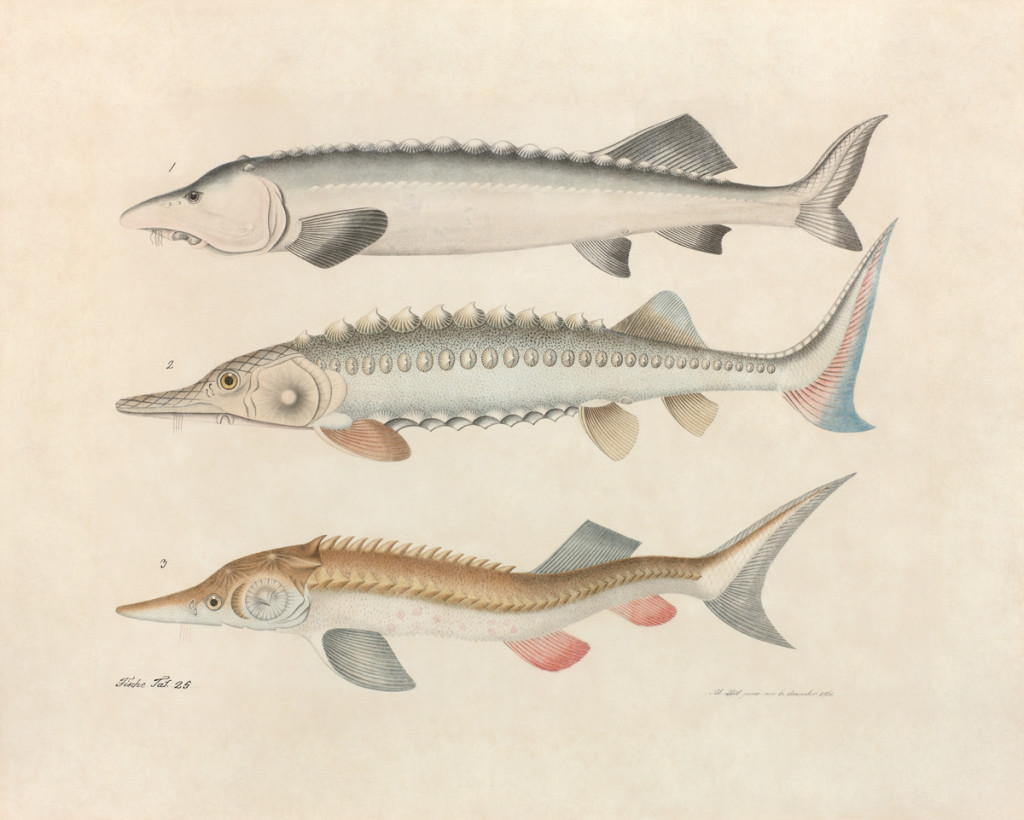Aloys Zötl
(Freistadt 1803 - 1887 Eferding)
Study of Three Sturgeon, 1861
Watercolour, pencil, pen and grey ink on paper, c.31 x 41 cm (image), 44 x 55 cm (sheet)
Signed and dated lower right Al. Zötl pinx. Am 6. Dezember 1861
Inscribed lower left Fische Taf. 25
Provenance:
Paris, Hôtel Drouot, auction sale 1958a, lot 208a (as Fische [6. Dez. 1861])
Literature:
Franz Reitinger, Aloys Zötl oder die Animalisierung der Kunst, catalogue raisonné, Vienna 2004, p.146
We are grateful to Johannes Schnell of the Landesfischereiverband Bayern for his assistance.
The Austrian artist Aloys Zötl devoted a long life to producing an extraordinary body of watercolours while plying his trade as a master dyer. These watercolours depicted animals, many of them exotic, fantastic and from remote countries he had never visited and specimens he had never examined. He assembled the watercolours in a bestiary which ran to four volumes and contained approximately 400 sheets. Today, the majority of the sheets are in private hands and are scattered among collections in France, Switzerland, Austria and the United States.
Zötl's oeuvre was relatively unknown until decades after his death. He was discovered and feted by the Surrealists in France. André Breton described the bestiary as the most magnificent book on animals the world had ever produced. He included Zötl in his list of Surréalistes avant la letter. This list also included Le Douanier Rousseau (compare Fig. 1).[1]
Zötl's chief interest was that of an encyclopedist, where it is the surreal and naive qualities of his work which are of interest today. The images were not entirely true to life, especially in terms of detail, although the bestiary is systematically structured according to species - first mammals, then fish, molluscs, reptiles, birds, insects, batrachia and finally, cnidaria.
The genesis of these remarkable watercolours lies in nineteenth-century colonialism - one of its many manifestations was an enthusiasm for the exotic, particularly with regard to flora and fauna. The Habsburg Empire was a leading protagonist in the international race to obtain colonies and natural resources. Expeditions were fitted out to explore and exploit new territories, the best known being the expeditions led by Alexander von Humboldt. Expeditionary artists were hired to make records of what they encountered. When Archduchess Maria-Leopoldina of Austria, daughter of Kaiser Franz I of Austria, travelled to Rio de Janeiro in 1817 as the bride of Dom Pedro de Bragança, later Pedro I of Brazil, an expedition was sent ahead of her. Scientists, botanists and artists accompanied it, among them the painter Thomas Ender (1793-1875), who produced a prolific body of work. The founding of the 'Brasilianum' or Brazilian Museum in Vienna in 1821 was one of the results of this expedition. Records show that Zötl was an enthusiastic visitor.[2] This and the general enthusiasm for the exotic provided fertile ground for Zötl's oeuvre.
It is unlikely that Zötl examined the three sturgeon depicted in the present watercolour in natura. The sheet almost certainly represents three species of European sturgeon, each of which was native to the Danube in Zötl's lifetime.[3] His probable source was a book titled Die Süßwasserfische der österreichischen Monarchie mit Rücksicht auf die angrenzenden Länder, published in 1858 - he often had to draw on contemporary natural history publications.
Sturgeon are one of the largest European fish to breed in rivers and some species can grow up to a length of five metres. Zötl's depiction of the skin is accurate. Sturgeon usually vary in colour dorsally from light to dark brown but they can also be slate grey or bluish-black to black. The weight of the roe can reach twenty per cent of the overall weight of the fish. Several species of sturgeon are harvested for their roe. The Beluga sturgeon, a native of the Danube basin, is noted for its caviar.
[1] Three hundred and twenty of his watercolours were sold at auction - for record prices - in 1955-6.
[2] In a letter to his family in 1825 Zötl describes his visit to the Museum and the exhibits he saw there. See Reitinger, op. cit., p.86.
[3] The physical characteristics of Zötl's fish identify them as sturgeon. These are: - form of head and snout (rostrum) - dorsal and lateral bony plates (scutes) - heterocercal (= asymmetrical and forked) caudal fin.
A definitive classification of the species is, however, not possible. Johannes Schnell proposes a tentative evaluation (from top):
1. Hausen (Huso huso, Beluga)
2. Stellate sturgeon (Acipenser stellatus)
3. Sterlet (Acipenser ruthenus)
For images of six varieties of Danube sturgeon, see <http://www.dstf.eu/species/> (accessed 27.01.2014).


